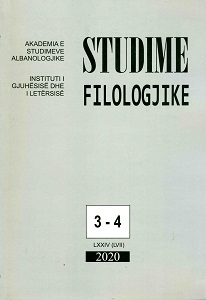Jehona e alfabetit të Stambollit në shtypin shqiptar të kohës
The Istanbul Society Alphabet in the Light of the Albanian Renaissance Press
Author(s): Rami MemushajSubject(s): Language studies, Media studies, Communication studies, Sociology
Published by: Qendra e Studimeve Albanologjike
Keywords: Albanian Renaissance Press; Istanbul Society Alphabet;
Summary/Abstract: One of the most important acts of our national Renaissance is, without doubt, the effort of the Istanbul Albanian intellectuals to create for our language a unified alphabet, based on Latin letters. These efforts that had started from the seventh decade of the XIX century, were successfully coronated in February 1789. At that time, an Alphabet Commission, with members such as Hasan Tahsini, Vaso Pasha, Koto Hoxhi, Jani Vreto, Sami Frashëri etc., from four proposed alphabets, chose a Latin based one, elaborated by S. Frashëri, based on the principle “a simple letter for each phoneme of Albanian”. According to him, the adoption of the Latin alphabet as a basis is explained by the fact that “Albania is a piece of Europe, ...therefore Albanian should also be written with European letters, i.e. with Latin letters”. The Istanbul Alphabet, known as the alphabet of the “Society for the printing of Albanian books” (‘Shoqëri e të Shtypurit Shkronja Shqip’, founded in Istanbul on October 12th, 1879), was hailed by Albanian cultural circles outside Albania as a major cultural event and had wide coverage in the Renaissance press. Various Albanian newspapers wrote about it, beginning with Anasats Kullurioti’s “I foni tis Alvanias”, and continuing later on by the Nikolla Naço’s newspaper “Shqipëtari”, De Rada’s “La nazione Albanese”, Visar Dodani’s “Shqipëria, and Faik Konica’s “Albania” journal as well as Kristo Luarasi’s “Kalendai Kombiar” etc. Positive evaluations of this alphabet continued for about two decades. According to researchers who have dealt with this issue, the Istanbul alphabet fulfills the scientific criterion, because it relies on the phonetic principle “a simple letter for each separate sound”; fulfills the political criterion, as it excludes the Greek and Arabic alphabets; fulfills the cultural criterion by choosing the Latin alphabet “as an alphabet used by many peoples of the world”. As for the practical side, Sami says that “it could be learned more easily and books could be printed with it anywhere”. But regarding the last two criteria two questions arise: why did the commission approve a mixed Latin-Greek alphabet and not a purely Latin one like that proposed by Vaso Pasha? And was this alphabet really practical, as Sami declares? The first question was answered by Asdreni and Visar Dodani, who pointed out that the Albanians lived in different regions and were divided into several religions, so it was necessary to choose an alphabet that did not offend the religious and national feelings of the Albanians. A purely Latin alphabet would offend the sentiments of the Orthodox and the Moslems; a Greek alphabet would touch the feelings of Catholics and Muslims; and, finally, a Turkish-Arabic alphabet would equate Albanians with Turks, insulting non-Turkic Christians and non-philoturkic Muslims, who were the majority of the county’s population. In other words, the choice of each of these three alphabets would not only not help the union, but would divide the Albanians even more. So, for the time, the right choice was made. But, when it was thought that the issue of the national alphabet was solved, the publication of most of the newspapers and journals with Latin based alphabets brought this issue back on the agenda. A heated debate began between the defenders of the Istanbul alphabet and the proponents of purely Latin alphabets, whose arguments for a pure Latin alphabet were of the cultural and practical nature. De Rada and F. Konica were the first to write about the shortcomings of the Istanbul alphabet, followed by A. Z. Çajupi, Asdreni, Aleksandër Xhuvani etc. The main arguments of the critics of the Istanbul alphabet had to do with the very nature of this alphabet, which, according to them, was a mixture of Latin, Greek and Slavic letters, and with the practical side - the absence of its special letters in printing houses where Albanian newspapers and magazines were printed, but also with the cultural aspect. Thus, Çajupi, one of the opponents of this alphabet, said that Albanians “must enter the right path and follow the path of all civilized nations, by choosing for Albanian an alphabet known by all the world”. Cultural reasons have also been pointed out by some newspapers. Thus, the newspaper “Shqipëtari” asked: “When the whole enlightened world serves with Latin letters, why do we Albanians quarrel among ourselves for the sake of some tyrants?” The demand for a fully Latin alphabet, expressed by some of the most renowned intellectuals of the time, testifies the tendency of the Albanian nation towards the West, towards the “sun that rises in the west”. This feature of the alphabetization of our language, which somewhere else we have called Latinity, permeates the entire first stage of the linguistic planning of Albanian. But the alphabetization phase would be called completed when a common alphabet was created. Regarding the way this issue should be resolved, different opinions were expressed in the Albanian press of the period under review. Some left the solution to a scientific institution, some saw the solution to an agreement reached in a general meeting, and others as something that could be achieved by accepting the opinion of the majority of respondents. Of these three opportunities, the holding of a language congress was used, as other countries had done. And it was punctually the Congress of Monastir that put an end to the odyssey of the Albanian Alphabet.
Journal: Studime Filologjike
- Issue Year: 2020
- Issue No: 03-04
- Page Range: 83-107
- Page Count: 25
- Language: Albanian

